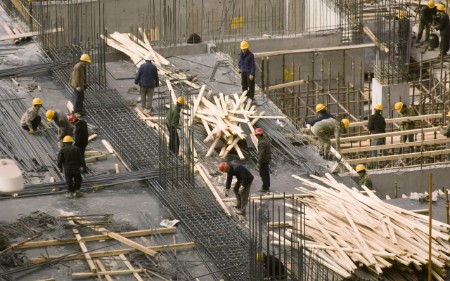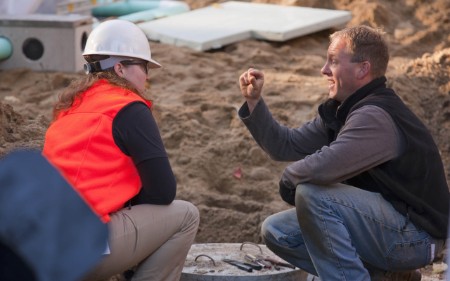
Chapter 1
Megacities mean mega-challenges
As city-dwellers around the world increase, crucial infrastructure is needed to meet growing demands.
In 1950 around 30% (pdf) of the world’s population lived in cities. Today, that figure is about 54%. By 2050, 66% of the global population will be city-dwellers.
“Cities are growing in size and number, which puts increasing pressure on infrastructure and services,” says Jesse Berst, Chairman of the Smart Cities Council, a nonprofit organization helping develop smart cities around the world, and with which EY has collaborated. Today, three million people are migrating to cities every week – the equivalent of a new Nairobi, Buenos Aires or Madrid every seven days.
These urban migrants will need houses. When they get ill, they will need new hospitals. Their children will need more schools. They will need more food and water, which will need to be brought in from outside the city limits in sufficient quantities to prevent shortages.
Failing to provide this crucial infrastructure could risk driving cities to a halt, with major consequences for the world economy. In notoriously congested Manila, in the Philippines, traffic jams cost the economy about $57 million every day in lost productivity. That figure could hit $142 million by 2030.
The Tokyo metropolitan area has a population of around 37 million people. Those people are served by 24,000 kilometers of road. They are treated in more than 600 hospitals. They make 8.7 million journeys every day on its metro system. Now imagine how much new infrastructure will be needed to serve just one of China’s 100-million-person megacities.

Chapter 2
Expanding, upgrading and improving our cities
Cities need more than new infrastructure. We need to upgrade existing infrastructure to become smart and resilient for the future.
The challenges of preparing for the future do not stop at providing new infrastructure for incoming populations. Equally important is boosting urban communities’ resilience through renovating existing infrastructure, much of which is decaying and no longer fit for purpose.
For instance, the US water system is still operating on pipelines that were first laid in the 1920s. These pipelines now need to be replaced, which the American Water Works Association expects will cost about $1 trillion over the next 25 years. Failure to do so has serious consequences, as the case of lead poisoning in Flint, Michigan attests.
And this is just one small piece of the puzzle. Roads, bridges, and power networks all need regular and expensive maintenance to ensure the continued smooth functioning of urban spaces and economies. Often, these less glamorous, long-term projects can be neglected by legislators looking for short-term wins, or hesitant about accepting responsibility for the near-inevitable disruption of daily life that such work requires.
Building environmental resilience
The city planners of the future will need to make sure the cities they design can withstand what the world throws at them, particularly when it comes to environmental challenges.
There are technological solutions. Japan sits on top of a series of major tectonic fault lines, and earthquakes are frequent, but it has built its infrastructure to accommodate this fact. When the first tremors of the 2011 Tohoku earthquake were detected, automated warning systems (pdf) stopped all the trains in the region. No trains were derailed, and no elevated railway bridges collapsed, despite this being one of the most powerful earthquakes on record.
Conversely, failing to account for environmental challenges in civic planning can have serious consequences. The lack of zoning laws in Houston led to decades of building on the city’s wetlands – between 1992 and 2010 about 70% of these environments were lost to development. However, those wetlands perform essential drainage functions. When Hurricane Harvey hit in August 2017, floodwaters had nowhere to go, exacerbating the damage to the city.
Finding the balance between the need to build and maintaining vital ecological systems will be critical as cities expand, and changing climates mean extreme weather events grow more common.
Accommodating the future
“At the same time [as demographic shifts], the rise of digital and mobile are generating more data, different demands and different ways of interacting with cities,” says Berst. These demands will need to be catered for, if cities are to becoming truly “smart” – that is, cities in which digital integration, urban planning and economic dynamism go hand-in-hand.
Barcelona has managed to make itself one of the world’s smartest cities, with dustbins that alert civic authorities when they need to be collected, traffic cameras that can be accessed from smartphones, and under-road sensors that alert motorists to free parking spaces.
However, none of this would have been possible without the city-wide fiber-optic refit the city received in the run-up to the 1992 Summer Olympic Games. Songdo in South Korea, another of the world’s smartest cities, was built from scratch to be an explicitly smart, resilient city. These preparations allowed for the easy implementation of smart city infrastructure, like data-capturing systems and self-optimization technologies. Not all cities will enjoy such advantages.
And this is just to accommodate today’s technology. If radical transport innovations like autonomous vehicle fleets, the Hyperloop or even the long-awaited flying car take off, will cities be able to provide them with the infrastructure they need? Perhaps the homes of the future will need landing pads and hangars, instead of garages and driveways. As science fiction as it sounds, Dubai and Dallas are already developing air-taxi schemes.
It’s important to leave this space for innovation. When Baron Haussmann rebuilt Paris along grand boulevards and wide-open spaces in the mid-19th century, it was on the cutting edge of contemporary urban planning. These streets now give the city its distinctive character – anyone trying to redevelop Paris on a Hausmannian scale today would meet fierce resistance.
But without the right development at the right time, a city like Paris could become the next Venice – a beautiful tourist destination whose restrictive, antiquated infrastructure (there are no cars on the lagoon island) makes it all but incapable of participating in a modern, global economy. Resilience means preparing for all eventualities, even the unknowns of new technology.

Chapter 3
Paying for the cities of the future
Funding smart-city upgrades will fall to both the public and private sector.
Governments around the world recognize the importance of budgeting for these future needs. One pillar of US President Donald Trump’s 2016 election campaign was a $1 trillion infrastructure investment pledge. This is dwarfed by Chinese President Xi Jinping’s One Belt, One Road initiative, which aims to invest trillions of dollars into building a network of logistics and communications infrastructure that will span much of Eurasia.
In total, cities around the world are expected to spend around $41 trillion on smart-city upgrades over the next 20 years.
Not all of this investment will flow from the public sector – the private sector too will play a considerable role in creating the smart, resilient cities of the future, from institutional finance providing funding to companies innovating within their own operations. During 2016, the private sector invested a record total of $413 billion (pdf) in unlisted (privately owned) infrastructure assets, up 14% on the previous year’s figures.
Getting funding where it’s needed
While no one denies the need for major infrastructure improvement works, the risks and complexities of such large-scale infrastructure improvement projects are immense. The length of time they take mean that any potential return on investment can seem too uncertain and far off to be worth the risk to invest now to develop a solution to a problem or need that may be years in the future.
Increasingly, more creative financing solutions are needed for major infrastructure improvement projects as well. With costs increasingly too great for one company – or even one government – to afford alone, and with projects increasingly dependent on other, related work, cross-sector collaboration and coordination is becoming the norm.
Building the right networks – like public-private partnership (PPPs), or private-finance initiatives (PFIs) – learning how to measure risk and return, and making the right funding available, will be critical to help these businesses improve their operations.

Chapter 4
Understanding the long-term value of urban infrastructure
Change isn't always easy. Organizations need to communicate the value of new infrastructure to all stakeholders to succeed.
Private investors are keen to invest in infrastructure – in general it’s seen as safe investment and is particularly attractive to deep-pocketed institutions, such as pension funds. But how should investors pick what to invest in? Return-on-investment (ROI) metrics can provide this. Understanding how a project is generating value, and what kind of shareholder returns can be expected, is essential in gaining the confidence of investors. For instance, it might be easy for investors to understand the value of a private toll road. Making the case for private investment in a bridge without toll gates may be less clear.
ROI metrics also need to take into account other externalities that direct return on profit. EY worked with the city of Kochi in India to help modernize its transport infrastructure. In that instance, ROI metrics didn’t just take into account the direct effects of the project in reducing congestion, but also how improved transport links connected local businesses. We even helped develop a card that customers can use on both transport and for shopping, helping to create a seamless experience between the use of transport and the purpose for which the transport was being used.
Value doesn’t just mean how much money an asset returns, as boards are beginning to realize. Long-term value goes beyond the balance sheet and can include things as diverse community cohesion, communications, civic pride and environmental sustainability.
Developing models that can capture the whole economic impact of development initiatives will be a key step in fully unleashing the dynamism of private-sector investment, and then building products to further encourage these trends.
Political priorities and competing demands
There could also be adverse regulatory and legislative head winds – despite public commitments, including President Trump’s $1 trillion investment pledge, populist anti-globalization trends could complicate the ability of developers to source the necessary materials, goods and labor needed for infrastructure projects – construction, in particular, is a sector facing major global skills shortages.
On top of this, citizens, particularly in democratic societies, have the power to derail projects through protest and activism, or to delay them through petitions to local government. The concept of the NIMBY protestor (“Not in my back yard”) is most common in the US and UK, but the type of opposition – not against the need for the development but with the location – is familiar in most countries.
Reconciling the interests of all stakeholders is crucial when developing large-scale infrastructure projects, such as dams or pipelines, which can have significant ecological and property impacts. For instance, the development of the third runway of Heathrow Airport in London has generated lots of controversy, as historically important local villages will need to be demolished to create the necessary space. China’s Three Gorges Dam, meanwhile, entailed the relocation of 1.24 million people.

Chapter 5
The way forward
Incentives, data and resilience will pave the way for the cities of the future.
The challenges of building cities resilient enough to meet the demographic, environmental, logistical and technological challenges of the future will require new ways of thinking and working, as well as new kinds of business initiatives and partnerships.
Learning to ask new and better questions, and building new approaches to tackling old problems, will be the role of any stakeholders, private or public, looking to be part of these solutions.
Incentivizing improvements
The appetite for investment is there. But both the public and private sectors have admitted shortcomings in how investment in improving urban resilience is directed and incentivized. In our recent infrastructure investment survey (pdf), more than 50% of both private and public sector respondents said that insufficient regulatory incentives were a major challenge in getting investment in resilience off the ground.
What might these incentives look like? In the study (pdf), EY and 100RC investigated key ways that the private and public sectors can work together to promote more impactful investments in infrastructure and resilience and provide the right metrics to capture that value across the whole life cycle, from financing to planning to measurement. These included:
- Developing standardized resilience metrics
- Working with philanthropic and development bank actors to innovate around process
- Exploring alternative financing methods
- Expanding public-private partnerships
- Setting shared goals for both public and private stakeholders
- Establishing clear metrics that can communicate the value of investments and measure impact
Data, the great enabler
A major trend that should aid the emergence of more resilient cities will be the increasingly central role of data in managing municipal issues, as cities – even the oldest ones – get smarter. But data may also play a key role in helping realize these cities in the first place, by helping to bridge the gap between public and private sector stakeholders, and helping different groups of stakeholders find new ways to collaborate in making cities more efficient and resilient.
Our work with Amsterdam’s city government provides an example of how data was used to help private and public stakeholders work together to thread resilience through civic infrastructure.
For instance, the retailers on Amsterdam’s exclusive shopping street Utrechtsestraat were looking for ways to reduce their carbon footprint. To do so, they asked to receive annual reports from the local government with personalized recommendations on how to reduce energy use. The project was so successful that a new smart meter was developed, which is now used in many Dutch households.
There were other applications too: “tapping into grocery-store data helped formulate and evaluate a city healthy-eating campaign for children,” says my colleague Frank Harmsen, Partner, Government & Public Sector, EY. “And private insurance companies helped gather data on city areas that needed more mental health services.”
Realizing resilience
The cities of 2030, 2050 and 2100 will be very different from today. They will be cities transformed: in their demographic composition, in their implementation of technology and in their wider ecological contexts.
But while we may not know exactly what pressures and forces may shape these futures, we do know we need to build resilience into our cities – today – to enable them to adapt to new, emerging demands. We know how to start forming these preparations, and we know what organizational steps we can take to make them. Now we have to go and do it.
“We want the urban resilience movement to flourish and to be something that we talk about in the same way we talk about sustainability, community policing or any of the big urban innovations of the last 20 years,” says Michael Berkowitz, President of the 100 Resilient Cities Initiative. “We don’t want this to be just the latest buzzword and then for things to move on.”
Related article
Related article
Summary
Building resilience infrastructure for cities today is vital in order to adapt to the demands of tomorrow.


